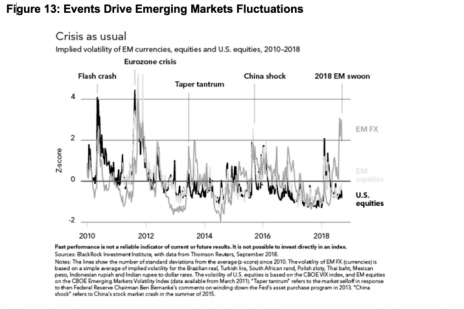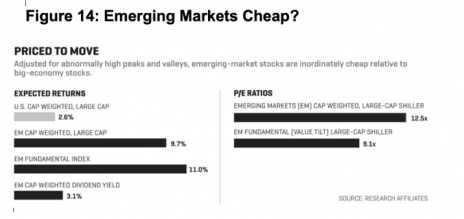Many investors use the terms ‘international’ and ‘global’ to mean the same thing. They don’t, and this distinction becomes more important if you invest in mutual funds or exchange-traded funds (which I’ll cover in a later chapter).
International investing includes investing in all countries other than the one in which you reside, while global investing covers all countries all over the world, including your home country’s domestic investments.
Emerging Markets are economies that are between the stages of “developing” and “developed,” those countries that tend to be undergoing rapid growth. The Morgan Stanley Capital International Emerging Market Index lists 25 countries as emerging markets, including:
- Brazil
- Chile
- China
- Colombia
- Czech Republic
- Egypt
- Greece
- Hungary
- India
- Indonesia
- Korea
- Malaysia
- Mexico
- Morocco
- Qatar
- Peru
- Philippines
- Poland
- Russia
- South Africa
- South Korea
- Taiwan
- Thailand
- Turkey
- United Arab Emirates.
Frontier Markets are less developed than emerging countries, but not the least-developed countries. The MSCI Frontier Markets Index includes:
- Argentina
- Bahrain
- Bangladesh
- Burkina Faso
- Benin
- Croatia
- Estonia
- Guinea-Bissau
- Ivory Coast
- Jordan
- Kenya
- Kuwait
- Lebanon
- Lithuania
- Kazakhstan
- Mauritius
- Mali
- Morocco
- Niger
- Nigeria
- Oman
- Romania
- Serbia
- Senegal
- Slovenia
- Sri Lanka
- Togo
- Tunisia
Advantages to Foreign Investing
There are lots of good reasons for investing abroad, including:
Global Diversification: 76% of the world’s companies valued over $1 billion in market cap live outside of the U.S. and account for 48% of global equity markets. With this abundance, you would think U.S. investors would jump on the global bandwagon, but just 22% of retail investors’ portfolios include non-U.S. stocks. And that number is estimated to shrink to 17% by 2060.
Growth: Multinational corporations—companies doing business outside their home countries—are expanding at a rapid rate, offering increasing global exposure opportunities for investors. Publicly-traded companies from 60 countries occupy Forbes Global 2000 list and account for $39.1 trillion in sales, $3.2 trillion in profit, $189 trillion in assets and $56.8 trillion in market value. The U.S. is still number one, with about 30% of the total number of companies. But Asia is catching up. China and Hong Kong have 291 companies on the list (up from 262 in 2017, and considerably more than the 43 companies that made it on the initial list in 2003.
Better Returns: As you can see in the following graph (Figure 12), for the past 25 years, as measured by the S&P 500 Index, global stocks often had better average returns than domestic stocks.
Consumption of Foreign Goods: The U.S. imports $2.4 trillion of goods each year, including food, automobiles, electronics, industrial, consumer, and capital goods. By owning stocks in other countries, investors can participate in this growing trend.
Global Small-Cap Diversification: Diversification through exposure to value, small-cap, and emerging market stocks. Multinationals will give you international exposure, but most of those companies are large-cap, so if you invest in foreign equities, you will also gain exposure to smaller (and more speculative) foreign companies.
Currency Diversification: Currency investments can help or hurt you; so, you must pay attention to the strength of the dollar when investing in currency (mostly done through funds and ETFs), as well as monetary policies in the country in which you invest.
Risks
But there are also significant risks to investing abroad, including:
- Fluctuations in currency exchange rates, as mentioned above
- Volatility, with the possibility of substantial changes in market value. As this chart (Figure 13) depicts, political, social, and economic news can significantly roil foreign markets.
- Low liquidity. With lower trading volumes and fewer securities, it may be more difficult to buy and sell securities during your time frame.
- Markets in foreign countries will most likely operate differently than those in the U.S., so you will need to understand the differences.
- Excessive debt can derail an economy and subsequently, an entire stock market.
- Less access to important information. As many countries are not bound by accounting rules like we have in the U.S., it may be difficult to interpret financial statements.
- Transaction costs may be quite a bit higher than what you would incur when buying or selling a U.S. stock or fund.
- Trade skirmishes, as we are seeing today with China and the U.S. can affect investments in foreign as well as multinational companies.
How to Participate in Foreign Investment Markets
There are several methods in which you can buy stocks in foreign companies, including:
- An American Depositary Receipt (ADR) is a negotiable certificate issued by a U.S. bank representing a specified number of shares (or a single share) in a foreign stock traded on a U.S. exchange.
- A Global Depository Receipt (GDR) is a bank certificate issued in multiple countries for shares in a foreign company. They trade as domestic shares and can be purchased through various banks around the world. You’ll find the majority of GDRs on the London and Luxembourg Stock Exchanges.
- Multinational Corporations—companies that generate a good portion of their sales from their foreign operations.
- Direct Investing. Not all countries are open to direct investing by non-citizens, but many companies in foreign countries list their shares on U.S. stock exchanges, in addition to their own country’s exchanges. For companies not listed on U.S. Exchanges, you can invest in two ways: 1) Opening a global account with a broker that allows trading in foreign stocks, in your home country. Many brokerages in the U.S. provide this service, including Fidelity, E*TRADE, Charles Schwab, or Interactive Brokers. 2) In some cases, you can also open an account with a local broker that offers services to international investors, in the country in which you wish to invest.
However, investing directly in foreign countries carries lots of risk, including currency conversions, understanding financial regulations and statements, high costs, taxation difficulties, as well as adequate customer support, or even fraudulent brokers.
Two less challenging and less risky methods of foreign investing are:
- Mutual Funds and Exchange-Traded Funds (ETFs). Investors can depend on the research and often ‘boots on the ground’ analysts who understand their specific targeted countries and/or investments. And they come in lots of flavors: sector, country, or region-weighted; growth or value; conservative or aggressive.
Why Invest now in Global Stocks?
After a fantastic 2017 U.S. market, stocks in 2018 were a lesson in volatility. This prompted some experts to look further afield for investments and see the following possibilities:
Europe seems to be stabilizing, after years of currency, inflation, geopolitical and economic problems.
Emerging market stocks have taken it on the chin which makes them look very undervalued right now. But be aware, emerging stocks are often high-risk, high-reward opportunities.
How Much is Too Much to Invest?
The answer to how much is too much to invest in global stocks, of course, depends on your personal investing style and risk profile. In general, many investment pros recommend about a 30% allocation to global stocks (and no more than 50%).
Face it. We are a global economy today—interdependent upon each other for trade, safety, and growth. So, why not participate in the full range of stocks offered throughout the world? Investing globally can help you mitigate risk by diversifying while increasing your gains as you obtain exposure to high-growth regions of the world.




